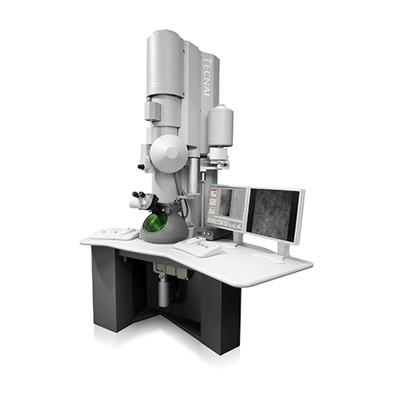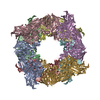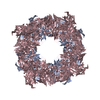[English] 日本語
 Yorodumi
Yorodumi- EMDB-3725: Negative-stain EM structure of the A. tumefaciens outer-membrane ... -
+ Open data
Open data
- Basic information
Basic information
| Entry | Database: EMDB / ID: EMD-3725 | |||||||||
|---|---|---|---|---|---|---|---|---|---|---|
| Title | Negative-stain EM structure of the A. tumefaciens outer-membrane core complex | |||||||||
 Map data Map data | ||||||||||
 Sample Sample |
| |||||||||
| Biological species |  Agrobacterium tumefaciens (bacteria) Agrobacterium tumefaciens (bacteria) | |||||||||
| Method | single particle reconstruction / negative staining / Resolution: 21.0 Å | |||||||||
 Authors Authors | Costa TRD / Orlova EV / Waksman G | |||||||||
 Citation Citation |  Journal: Mol Microbiol / Year: 2017 Journal: Mol Microbiol / Year: 2017Title: Use of chimeric type IV secretion systems to define contributions of outer membrane subassemblies for contact-dependent translocation. Authors: Jay E Gordon / Tiago R D Costa / Roosheel S Patel / Christian Gonzalez-Rivera / Mayukh K Sarkar / Elena V Orlova / Gabriel Waksman / Peter J Christie /   Abstract: Recent studies have shown that conjugation systems of Gram-negative bacteria are composed of distinct inner and outer membrane core complexes (IMCs and OMCCs, respectively). Here, we characterized ...Recent studies have shown that conjugation systems of Gram-negative bacteria are composed of distinct inner and outer membrane core complexes (IMCs and OMCCs, respectively). Here, we characterized the OMCC by focusing first on a cap domain that forms a channel across the outer membrane. Strikingly, the OMCC caps of the Escherichia coli pKM101 Tra and Agrobacterium tumefaciens VirB/VirD4 systems are completely dispensable for substrate transfer, but required for formation of conjugative pili. The pKM101 OMCC cap and extended pilus also are dispensable for activation of a Pseudomonas aeruginosa type VI secretion system (T6SS). Chimeric conjugation systems composed of the IMC joined to OMCCs from the A. tumefaciens VirB/VirD4, E. coli R388 Trw, and Bordetella pertussis Ptl systems support conjugative DNA transfer in E. coli and trigger P. aeruginosa T6SS killing, but not pilus production. The A. tumefaciens VirB/VirD4 OMCC, solved by transmission electron microscopy, adopts a cage structure similar to the pKM101 OMCC. The findings establish that OMCCs are highly structurally and functionally conserved - but also intrinsically conformationally flexible - scaffolds for translocation channels. Furthermore, the OMCC cap and a pilus tip protein coregulate pilus extension but are not required for channel assembly or function. | |||||||||
| History |
|
- Structure visualization
Structure visualization
| Movie |
 Movie viewer Movie viewer |
|---|---|
| Structure viewer | EM map:  SurfView SurfView Molmil Molmil Jmol/JSmol Jmol/JSmol |
| Supplemental images |
- Downloads & links
Downloads & links
-EMDB archive
| Map data |  emd_3725.map.gz emd_3725.map.gz | 378.7 KB |  EMDB map data format EMDB map data format | |
|---|---|---|---|---|
| Header (meta data) |  emd-3725-v30.xml emd-3725-v30.xml emd-3725.xml emd-3725.xml | 7.7 KB 7.7 KB | Display Display |  EMDB header EMDB header |
| Images |  emd_3725.png emd_3725.png | 116.6 KB | ||
| Archive directory |  http://ftp.pdbj.org/pub/emdb/structures/EMD-3725 http://ftp.pdbj.org/pub/emdb/structures/EMD-3725 ftp://ftp.pdbj.org/pub/emdb/structures/EMD-3725 ftp://ftp.pdbj.org/pub/emdb/structures/EMD-3725 | HTTPS FTP |
-Validation report
| Summary document |  emd_3725_validation.pdf.gz emd_3725_validation.pdf.gz | 204.2 KB | Display |  EMDB validaton report EMDB validaton report |
|---|---|---|---|---|
| Full document |  emd_3725_full_validation.pdf.gz emd_3725_full_validation.pdf.gz | 203.4 KB | Display | |
| Data in XML |  emd_3725_validation.xml.gz emd_3725_validation.xml.gz | 5.3 KB | Display | |
| Arichive directory |  https://ftp.pdbj.org/pub/emdb/validation_reports/EMD-3725 https://ftp.pdbj.org/pub/emdb/validation_reports/EMD-3725 ftp://ftp.pdbj.org/pub/emdb/validation_reports/EMD-3725 ftp://ftp.pdbj.org/pub/emdb/validation_reports/EMD-3725 | HTTPS FTP |
-Related structure data
| Similar structure data |
|---|
- Links
Links
| EMDB pages |  EMDB (EBI/PDBe) / EMDB (EBI/PDBe) /  EMDataResource EMDataResource |
|---|
- Map
Map
| File |  Download / File: emd_3725.map.gz / Format: CCP4 / Size: 8 MB / Type: IMAGE STORED AS FLOATING POINT NUMBER (4 BYTES) Download / File: emd_3725.map.gz / Format: CCP4 / Size: 8 MB / Type: IMAGE STORED AS FLOATING POINT NUMBER (4 BYTES) | ||||||||||||||||||||||||||||||||||||||||||||||||||||||||||||
|---|---|---|---|---|---|---|---|---|---|---|---|---|---|---|---|---|---|---|---|---|---|---|---|---|---|---|---|---|---|---|---|---|---|---|---|---|---|---|---|---|---|---|---|---|---|---|---|---|---|---|---|---|---|---|---|---|---|---|---|---|---|
| Projections & slices | Image control
Images are generated by Spider. | ||||||||||||||||||||||||||||||||||||||||||||||||||||||||||||
| Voxel size | X=Y=Z: 3.3 Å | ||||||||||||||||||||||||||||||||||||||||||||||||||||||||||||
| Density |
| ||||||||||||||||||||||||||||||||||||||||||||||||||||||||||||
| Symmetry | Space group: 1 | ||||||||||||||||||||||||||||||||||||||||||||||||||||||||||||
| Details | EMDB XML:
CCP4 map header:
| ||||||||||||||||||||||||||||||||||||||||||||||||||||||||||||
-Supplemental data
- Sample components
Sample components
-Entire : Type IV secretion outer-membrane core complex from A. tumefaciens
| Entire | Name: Type IV secretion outer-membrane core complex from A. tumefaciens |
|---|---|
| Components |
|
-Supramolecule #1: Type IV secretion outer-membrane core complex from A. tumefaciens
| Supramolecule | Name: Type IV secretion outer-membrane core complex from A. tumefaciens type: complex / ID: 1 / Parent: 0 |
|---|---|
| Source (natural) | Organism:  Agrobacterium tumefaciens (bacteria) Agrobacterium tumefaciens (bacteria) |
-Experimental details
-Structure determination
| Method | negative staining |
|---|---|
 Processing Processing | single particle reconstruction |
| Aggregation state | particle |
- Sample preparation
Sample preparation
| Buffer | pH: 8 |
|---|---|
| Staining | Type: NEGATIVE / Material: Uranyl Acetate |
- Electron microscopy
Electron microscopy
| Microscope | FEI TECNAI F20 |
|---|---|
| Image recording | Film or detector model: GATAN ULTRASCAN 4000 (4k x 4k) / Average electron dose: 30.0 e/Å2 |
| Electron beam | Acceleration voltage: 200 kV / Electron source:  FIELD EMISSION GUN FIELD EMISSION GUN |
| Electron optics | Illumination mode: FLOOD BEAM / Imaging mode: BRIGHT FIELD |
| Experimental equipment |  Model: Tecnai F20 / Image courtesy: FEI Company |
- Image processing
Image processing
| Final reconstruction | Resolution.type: BY AUTHOR / Resolution: 21.0 Å / Resolution method: FSC 0.5 CUT-OFF / Number images used: 1746 |
|---|---|
| Initial angle assignment | Type: ANGULAR RECONSTITUTION / Software - Name: IMAGIC |
| Final angle assignment | Type: ANGULAR RECONSTITUTION / Software - Name: IMAGIC |
 Movie
Movie Controller
Controller








 Z (Sec.)
Z (Sec.) Y (Row.)
Y (Row.) X (Col.)
X (Col.)





















